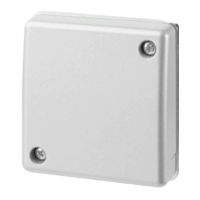Seismic Detectors Application Guide
2. Calculate the maximum distance between the corner of the protected wall and the first detector
(d1). The figure for d1 is also used for the distance between the last detector and the far corner
of the wall (d2).
The formula to determine d1 (and d2) is:
d1 = r x 0.8
3. Calculate maximum spacing distance between two detectors (sd
max
). The formula to determine
the maximum allowable spacing distance sd
max
between two detectors is:
sd
max
= r x (2 x 0.75)
4. Determine the required number of detectors (n).
𝒏 =
𝒍 −
(
𝒅𝟏 + 𝒅𝟐
)
𝒔𝒅
𝒎𝒂𝒙
+ 1
If n is greater than a whole number, then roundup to the nearest whole number. For
example, if n = 4.1, roundup to 5. Therefore, n = 5.
For example:
Calculate the location and spacing of the detectors for a wall that is 25m long and 3m high. Oper-
ating radius of the detector is set to 4m. In this example, the height of the wall is less than twice
the operating radius of the detector, so all detectors can be located on the horizontal centre-line of
the wall.
a) Determine the length (l) and height (h) of the protected surface alongside the operating radius
(r).
l= 25m
h= 3m
r= 4m
b) Calculate distance from corner to first detector d1.
d1 = r x 0.8
d1 = 4 x 0.8
d1 = 3.2m
Note: The figure for d1 is also used for the distance between the last detector and the far cor-
ner of the wall (d2 = 3.2m).
c) Calculate the spacing distance sd
max
sd
max
= r x (2 x 0.75)
sd
max
= 4 x (2 x 0.75)
sd
max
= 6m
d) Determine the required number of detectors (n).
𝒏 =
𝒍 −
(
𝒅𝟏 + 𝒅𝟐
)
𝒔𝒅
𝒎𝒂𝒙
+ 1
𝒏 =
25 −
(
3.2 + 3.2
)
6
+ 1
n = 3.1 + 1
n = 4.1
n = 5
This calculation determines that 5 detectors are required for this protected surface.
If n is greater than a whole number, then roundup to the nearest whole number. For
example, if n = 4.1, roundup to 5. Therefore, n = 5.
6.3.2 Manually adjusting the detector locations
Under certain conditions the sum of the manually calculated d1, sd
max
, and d2 distances may exceed
the length of the protected surface for the number of detectors n (see Table 6-1: Manually calculated
detector locations).

